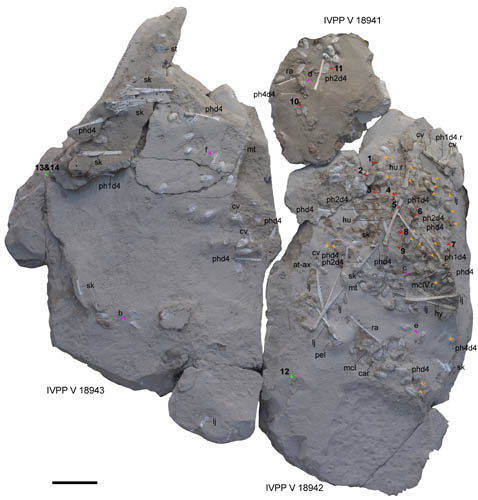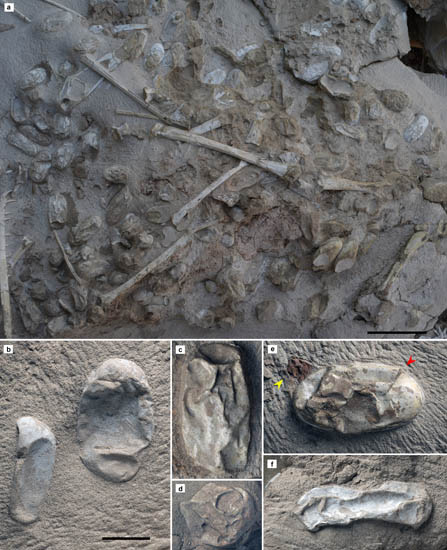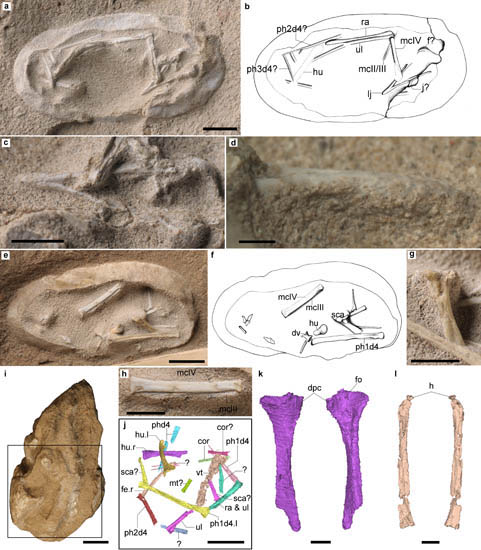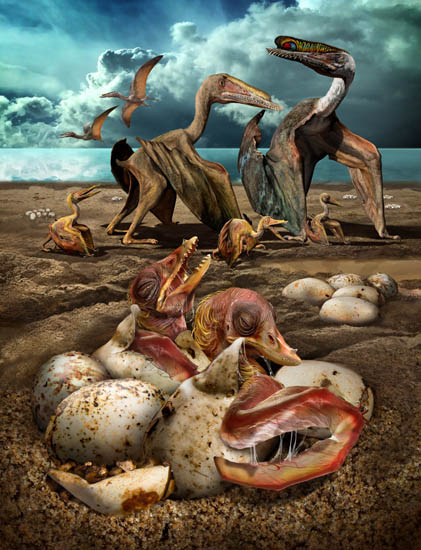The Xinjiang Hami scientific expedition team led by researcher Wang Xiaolin from the Institute of Vertebrate Paleontology and Paleoanthropology of the Chinese Academy of Sciences and the University of Chinese Academy of Sciences, after more than ten years of continuous field scientific research, discovered and discovered in the Lower Cretaceous strata of the Hami Gobi in Xinjiang. An important specimen of more than 200 pterosaur eggs, embryos and bone fossils was collected in a rescue operation. 16 of the pterosaur eggs contained three-dimensional embryonic fossils. This is the first time in the world that 3D pterosaur embryos have been discovered. On December 1, 2017, the American magazine Science published online the important results of the discovery of Hami pterosaur eggs and embryos by an international collaborative team of scientists from China and Brazil. This is another important discovery after the discovery of a large number of male and female Hami pterosaurs in the Hami Desert in 2014 and the world's first three-dimensionally preserved pterosaur eggs.
Pterosaurs are the first type of flying vertebrates to fly into the sky and are the only extinct flying vertebrates on earth. Due to the need for flight, they evolved slender, hollow bones. Therefore, pterosaur fossils are very rare around the world, and pterosaur eggs And embryonic fossils are even rarer. In addition to the 5 previously reported pterosaur eggs in the Hami pterosaur fauna, a total of 6 pterosaur egg fossils have been reported around the world. Among the 3 specimens containing pterosaur embryos, 2 are from China and 1 is from China. Argentina. The other three pterosaur eggs did not preserve embryos, and two of them were preserved at the same time as the egg-laying mother of Yiwu Kong pterosaurs. They were produced in the Yanliao biota in China. These pterosaur eggs were preserved in a two-dimensional flattened form. , only one three-dimensionally preserved pterosaur egg has been discovered in Argentina. Although the current research on pterosaur egg fossils has made some progress, because few fossils have been found and most of them are two-dimensional preservation, many biological issues such as embryonic development and reproductive strategies are difficult to explain.
In 2014, Current Biology, a magazine owned by Cell, reported in a cover article that Wang Xiaolin’s team discovered a large number of three-dimensionally preserved male and female Hami pterosaur individuals and their five egg fossils in Hami, Xinjiang, my country. , this is also the first reported three-dimensional preserved pterosaur egg in the world. Although these pterosaur egg fossils do not preserve embryos, they have given researchers a clear understanding of the shell structure of pterosaur eggs. The eggshell of Hami pterosaur is a double-layered structure composed of a thin outer layer of calcium and a thick inner layer of shell membrane, which is very similar to the "soft-shell eggs" of some living reptiles, such as the elaphe snake. The discovery and study of Hamipteryx, a new pterosaur group and its egg fossils, have made great progress in the sexual dimorphism, ontogeny, pterosaur eggs and eggshell microstructure, reproductive and ecological habits of pterosaurs. Some important progress. This discovery was considered "one of the most exciting discoveries in the 200 years of pterosaur research." British paleontologists also wrote a review article titled "Which came first, pterosaurs or pterosaur eggs?"
Hundreds of 3D pterosaur eggs and embryo fossils were discovered in Hami, confirming that pterosaurs had gregarious living habits. During the long-term field investigation in the Hami area, the scientific expedition team led by Wang Xiaolin has been inspecting thousands of square kilometers of the Gobi Desert for more than ten years and determined the release range, enrichment and burial patterns of pterosaur and dinosaur fossils. Among them, the pterosaur fossils are mainly produced from a set of storm-deposited gray-white lacustrine sandstone mixed with red mudstone gravels. The thickness of the storm event sedimentary layer rich in pterosaur eggs and skulls and other bone fossils is about 10-30 cm. On the 2.2-meter section, there are eight layers rich in pterosaur fossils, four of which contain pterosaur egg fossils. The specimen studied this time is composed of three interconnected sandstone blocks, with an exposed area of about 3.28 square meters. There are 215 pterosaur egg fossils that have been exposed, including the underlying pterosaur eggs that are not fully exposed. The number may be higher. It is large, estimated to have up to 300 pieces, and there are also more than ten skulls and mandibles, as well as a large number of bones behind the head. This stunning and exquisite fossil specimen includes egg fossils containing embryos scattered during field collection. A total of 16 pterosaur eggs containing embryos have been confirmed so far. The discovery of a large number of pterosaur eggs, embryos, skulls and other skeletal fossils shows that Hamipteropteryx had a gregarious living habit, and this is likely to be one of its breeding and egg-laying sites.
CT reconstruction and embryonic development research prove for the first time that the hind limbs of pterosaurs develop faster than the forelimbs, and the babies can only walk but not fly after hatching. Previously, due to the scarcity of research materials on pterosaur eggs and embryos, paleontologists' understanding of the embryonic and reproductive development of pterosaurs was still very limited. This research has made some important progress in this regard. 42 pterosaur egg fossils were microscopically repaired or CT scanned. 16 of them retained embryos, and their internal structures were observed under the microscope. It was found that the embryonic fossils were basically incomplete, with one to several bones, possibly This is because the embryos are at different stages of development, or it may be due to differences in the preservation of the bones, such as bones being lost or damaged during transportation and burial. Since a large number of pterosaur egg fossils gathered together have been transported over short distances caused by storms, and pterosaur eggs have the characteristics of "soft-shell eggs", it is normal that the embryonic fossils in all pterosaur eggs are missing to varying degrees. Therefore, it is difficult to determine the developmental stage of the embryo in each egg. In order to solve this problem, it is assumed that embryos at the same developmental stage are of the same size, so that the development level of pterosaur embryos can be confirmed by comparing the length of the bones. Three of the embryos (No. 11, 12, and 13) have humerus of similar length, which should be at a similar or the same stage of embryonic development. The other embryo (No. 7) has a humerus that is about 20% longer than the first three and may be at the same stage. later developmental stages. The smallest humerus fossil of a juvenile pterosaur discovered so far is about 18% and 40% longer than No. 7 and No. 13 respectively. Together with the previously collected humerus of sub-adult individuals, the researchers obtained a series of fossils from different embryos. Sequence of the humerus of Hamiopterus from developmental stages to subadults. In this series of humeri, the deltoid ridge of the pterosaur humerus accounts for 25.5% to 27.8% of the entire humerus length from embryonic to hatching individuals, and 31.5% to 37.1% in subadult individuals. This research method has been used in the study of Austral pterosaurs from Argentina to speculate on the developmental stages of pterosaurs. Hamiopterus is close to hatched embryos and sub-adult individuals with the only known Austral pterosaurs. The changes in the deltoid ridge of the humerus are consistent, so it is inferred that embryos 11 to 13 are all in an advanced stage of development, but the degree of development is not as good as that of the southern pterosaur embryos.
Embryo No. 12 is the only specimen with preserved head bones. After repair under a microscope, the almost complete ventral surface of the mandible was exposed. The dentary symphysis was not healed, and no trace of any teeth was found. Since teeth are usually strong and easily preserved as fossils, the lack of teeth here is difficult to explain by preservation. At present, only the world's first pterosaur embryo found in the Jehol Biota in western Liaoning has preserved teeth, which is different from the embryonic development of Hami pterosaur. It is speculated that the embryo of Hamiopterus may have been in an intraoval stage of development before tooth development, or that its teeth may have delayed germination, contrary to the embryonic development situation in lizards and crocodiles.
Embryo No. 13 is the one with the most complete skeleton of all embryos. CT scans and three-dimensional reconstructions were performed at the Key Laboratory of Vertebrate Evolution and Human Origins, Chinese Academy of Sciences. A very interesting phenomenon was discovered. Although the femur of Hamipteryx embryos has been fully developed, it has a femoral head consistent with that of a sub-adult or adult individual and a significantly shrunken femoral neck. This means that it is likely that Hamipteryx had the features after hatching. It has the ability to walk on land; at the same time, the humerus on its left and right sides are not fully developed, and it does not yet have a curved deltoid ridge. This structure is where pterosaurs attach the pectoral muscles related to flight, which means that pterosaurs After hatching, it is likely that it will not have the ability to fly, only the ability to walk.
In embryo 11, this phenomenon of incomplete development of the forelimbs was also observed. This time it's the scapula. In sub-adult or adult pterosaurs, the scapula will develop an obvious scapula process. This structure is present even on the smallest juvenile. This is the location where the teres major muscle is attached, this muscle. Plays an important role in lifting the wings during flight. However, this structure on the scapula of embryo 11 has not yet developed, which means that Hamiopterus may not have the ability to fly after hatching.
Based on the above research on embryos, scientists believe that the hind limbs of Hamipteryx developed faster than the forelimbs. After hatching, the infants had the ability to move on the ground, but could not fly yet. Because the teeth sprouted late, they probably could not actively hunt prey and needed to be fed or fed by their parents. care. This puts forward a new hypothesis or perspective for the first time. Although it is a relatively precocious embryonic development model, the development of pterosaur embryos is not as precocious as previously thought and requires the care of adult pterosaurs.
Bone histology research shows that pterosaurs have a relatively fast bone growth and development rate, revealing the growth and development history of pterosaurs for the first time. Due to the need for pterosaur flight, the bone walls of its body bones are very thin and mostly hollow inside. This is reflected in the bone tissue that the medullary cavity of pterosaur bones expands very quickly. The spongy bone in the center of the bone and the bone near the center are The bone density cannot be preserved and is occupied by the rapidly expanding medullary cavity. Therefore, if you want to understand the physiological information such as the ontogenetic stages of pterosaurs through bone histology, you need to study a complete series of individual specimens from juvenile to adult. So far, few pterosaur types can provide such complete information. Fossil material. Currently, only the southern pterosaur from Argentina has been studied bone histologically from juvenile to adult individuals.
Scientists selected two embryos of Hami Pterosaur and several long bones from juvenile to nearly adult individuals for research. This is also the first time in the world that histological sections and microstructure of pterosaur embryos have been studied. It was found that pterosaur embryos were mainly composed of woven bone, a type of bone tissue that contains a large number of blood vessels, represents the fastest bone growth rate, and is a type of bone tissue that only appears in embryonic and infancy. Several upper limb bones of different sizes from juveniles to sub-adults are mainly composed of fibrous bone, which is also a type of bone tissue that grows quickly, indicating that pterosaurs have a faster growth and development rate. However, there are differences in different stages of growth and development, that is, juvenile individuals only have fibrous bone; sub-adult individuals have inner ring-shaped bone plates, which are a slow-growing secondary bone tissue, representing that the medullary cavity has stopped growing. , is also a sign of sexual maturity; not only does the medullary cavity stop growing in individuals approaching adulthood, there will also be two layers of growth stagnation lines on the outermost layer. This is a sign left by the cyclic growth of the organism, representing one year, so it is closest to adulthood. The individual was at least 2 years old at the time of death, but had not yet fully reached adulthood.
The specific burial characteristics of the fossils show that large lake storm events caused the death of pterosaur colonies and were transported over short distances and quickly buried. Such a rich and unique burial of pterosaur eggs and bone fossils is unique in the world, so what is the reason? Through sedimentological and taphonomic observations, it was found that the Hami pterosaur eggs and bone fossils were mainly produced in a set of laterally unstable gray-white lacustrine sandstones rich in red mudstone gravels. These muddy gravels were not transported from outside the basin. It comes from endogenous materials in the basin. The thickness of the fossil-enriched layer is not large, and all fossils are without exception concentrated in high-energy storm deposits with gravels. Although the bone fossils are scattered and preserved, each slender and hollow bone is almost complete and slender. The skull teeth and thin headdress are both associated with the skull or jaw and are well preserved. Therefore, it is believed that these large numbers of pterosaur and pterosaur egg fossils may have experienced multiple lake storm events. Such high-energy storms passed through the pterosaur nests and destroyed pterosaur eggs and living pterosaurs of different sizes and genders. Brought to the shore of the lake, after a short period of floating and gathering, they were quickly buried together with the torn and scattered pterosaur remains.
One of the important results of the Chinese Academy of Sciences’ “Take the Lead” program’s continued support for basic research and active participation in the national “One Belt, One Road” initiative. Since 2005, researchers such as Wang Xiaolin, Zhou Zhonghe, Dr. Jiang Shunxing, Dr. Cheng Xin, and Dr. Wang Qiang, as well as technical staff such as Li Yan and Xiang Long, have cooperated with relevant departments of the Hami local government and Ma Yingxia of the Hami Museum to conduct research in Xinjiang. More than ten years of field investigation and fossil protection work have been carried out in the Hami Gobi Desert. The Chinese Academy of Sciences' implementation of the "Pioneer Action" plan and the National Natural Science Foundation's continued support for basic research in paleontology, as well as the long-term support of the Chinese Academy of Sciences' field excavation funds, played a crucial role in the major discovery of Xinjiang Hami Pterosaur and its egg fossils. . The Chinese Academy of Sciences and the Institute of Paleontology have actively responded to the national “Belt and Road” initiative and strengthened support for western my country, especially Xinjiang. The Institute of Paleontology signed a strategic cooperation agreement with the Hami Municipal Government in 2015 to assist in the construction of local museums and application for national geological parks. At the same time, The world's largest pterosaur fossil exhibition "Flying to the Cretaceous - Chinese Pterosaur Exhibition" was held at the Hami Museum. With the support of relevant local departments such as the Xinjiang Association for Science and Technology, an academician expert workstation and a scientific research institute at the Institute of Paleovertebral Research were established in Hami. Scientific research base, etc., assist local governments and competent authorities in effectively protecting this important natural heritage and guiding its development planning, etc., which is a model of hospital-site cooperation.
Keeping in mind the mission of scientists, the Hami scientific expedition team of the Institute of Vertebrate Paleontology, Chinese Academy of Sciences, silently conducted continuous investigations for more than ten years under the very difficult conditions of the Gobi Desert, and made a series of important fossil discoveries. Today, it has the largest and richest pterosaur fossil origin in the world. For the first time, a large number of male and female pterosaurs at different stages of development, hundreds of 3D pterosaur eggs and pterosaur embryos were discovered, which is important for understanding and revealing pterosaurs. The history of life and in-depth understanding of the Cretaceous paleoenvironment, paleoclimate and paleogeography are of great significance. These research results are also supported by a team of Chinese paleontologists led by Wang Xiaolin and academicians of the Brazilian Academy of Sciences and members of the National Museum of Brazil.One of the results of the long-term cooperation between the Brazilian paleontologist team led by Professor Alexander Kellner. Since 2003, paleontologists from the two countries have conducted long-term and extensive exchanges and cooperation in the fields of vertebrate paleontology, and have successively published in Nature, Science, PNAS, Internationally renowned journals such as Current Biology have published a series of research results. The cooperation between scientists from the two countries in the field of paleontology is also one of the earliest collaborations between the Chinese Academy of Sciences and the Brazilian Academy of Sciences. The main researchers of Hamipteryx, Wang Xiaolin and Zhou Zhonghe, were also elected as academicians of the Brazilian Academy of Sciences.
This project is supported by the National Natural Science Foundation of China, the Strategic Priority Science and Technology Project of the Chinese Academy of Sciences (Category B), and the field excavation funds and key deployment projects of the Chinese Academy of Sciences. The Key Experiment on Vertebrate Evolution and Human Origins of the Chinese Academy of Sciences provides equipment and technical support for CT scanning and bone tissue slicing.

Figure 1 More than two hundred pterosaur eggs preserved in sandstone (IVPP V 18941-18943). The red arrow indicates a pterosaur egg with an embryo; the green arrow indicates the position of the three pterosaur eggs in the CT scan; the orange arrow indicates a pterosaur egg without an embryo. The scale bar in the figure is 100 mm. (Photo provided by Wang Xiaolin)

Figure 2 Three-dimensionally preserved Hami pterosaur egg fossil. A is a partial enlargement, the scale bar is 10 cm; B-F show the egg fossils with different degrees of deformation, the scale bar is 1 cm. (Photo provided by Wang Xiaolin)

Figure 3 Embryo fossils of Pterosaurus Hami: embryo No. 12 (A-D), embryo No. 11 (E-H), and embryo No. 13 (I-L). A&B Photos and line drawings of embryo No. 12, the only Pterosaur Hami embryo with preserved head bones, scale bar 10 mm; C Magnified view of the back of the mandible, scale bar 5 mm; D Side view of the front of the mandible (back side on top), scale bar 1 mm; E&F Photos and line drawings of embryo No. 11, scale bar 10 mm; G Scapula, without development of the scapula attached to the teres major muscle, scale bar 5 mm; I Photo of embryo No. 13, the box shows the position of the embryo, scale bar 10 mm; J Three-dimensional reconstructed model after CT scan of embryo No. 13, scale bar 10 mm; K Incompletely developed humerus, scale bar 2 mm; L Almost fully developed femur, scale bar 2 mm. (Photo provided by Wang Xiaolin)

Figure 4 Ecological restoration of Hami pterosaur Figure 3 (drawn by Zhao Chuang)
animal tags: pterosaur embryo Hamiopterus fossil dinosaur
We created this article in conjunction with AI technology, then made sure it was fact-checked and edited by a Animals Top editor.